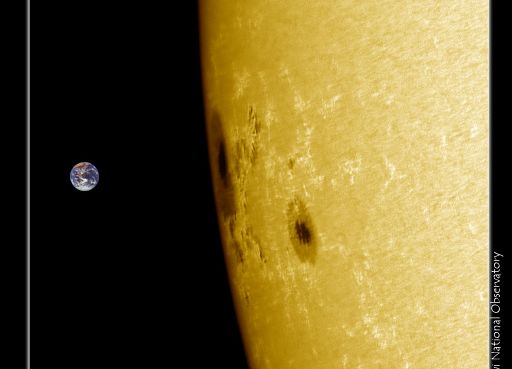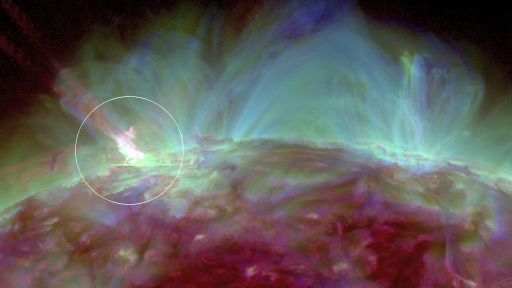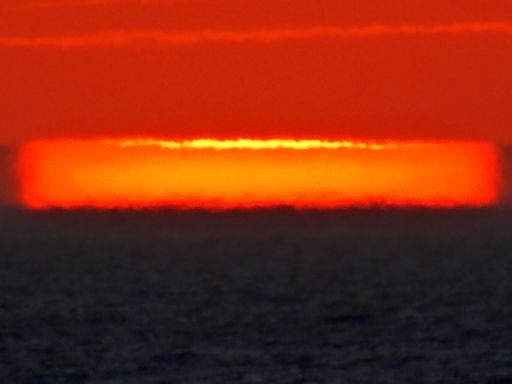
CHINESE MOON ROVER IN TROUBLE: China's moon rover, the Jade Rabbit, which made an historic landing in Sinus Iridum (the Bay of Rainbows) on Dec. 14th, is in trouble. Night is falling over the rover's landing site, and the rover should be going into hibernation to preserve power. China's space agency is reporting, however, that a "mechanical anomaly" may be interfering with the hibernation process. If so, the Jade Rabbit might not survive the extreme cold (-180 C) it is about to experience during two weeks of lunar night. Even if the rover fails, the mission is a success for China, which has joined the exclusive club of nations that have landed on the Moon.
OLD SUNSPOT RETURNS, SOLAR ACTIVTITY INCREASES: Crackling with solar flares, a large sunspot is emerging over the sun's southeactive limb. It appears to be AR1944, returning after a two-week trip around the farside of the sun. Earlier today, astronomer Karzaman Ahmad photographed the active region from the Langkawi National Observatory in Malasia:
According to tradition, sunspots that circle around the farside of the sun are re-numbered when they return. The new designation of AR1944 is AR1967. "Sunspot AR1967 is as big as Earth!" notes Ahmad.
Earlier this month, AR1944/AR1967 produced an X1-class solar flare and one of the strongest radiation storms of the current solar cycle. Is round 2 about to begin? Solar activity is definitely increasing as AR1967 comes around he bend. Earth orbiting satellites have detected at least five M-class solar flares since yesterday, including this one recorded on Jan. 28th (07:30 UT) by NASA's Solar Dynamics Observatory:
More flares are in the offing. NOAA forecasters estimate a 5% chance of X-flares and a 50% chance of M-flares during the next 24 hours. Solar flare alerts: text, voice
Realtime Space Weather Photo Gallery
RECTANGULAR SUN: No, it's not an alien planet. It's just Rio. On Jan. 23rd, Helio C. Vital looked out over the ocean from Rio de Janeiro, Brazil, and saw something out of this world--a rectangular sun:
As alien as it appeared, this was a phenomenon of Earth. "An inversion air layer next to the sea surface caused the top of the setting sun to acquire unusual shapes. In a matter of tens of seconds, it went from a saucer to a cup, then to a rectangle," says Vital.
Atmospheric optics expert Les Cowley explains further: "A mirage morphed the sun into a rectangular block brighter at its top edge. It is even more complex than it seems. Sun rays are deflected (refracted) through the different temperature layers of a temperature inversion, cold air trapped beneath warmer air, to form not one sun image but three or even more. The topmost bright strip is the sun grazing the top of the inversion layer. Beneath it are two or more sun images, half of them rising and the others descending. They overlap to form the rectangle. Other shots show the separate sun images."
"Look for these mock-mirages and their green flashes when the horizon shows a dark band of a temperature inversion," he advises. "But take care and never ever use binoculars or a telescope. Magnified sunlight can cause serious eye damage."

Solar wind
speed: 355.0 km/sec
density: 1.3 protons/cm3
explanation | more data
Updated: Today at 1559 UT
X-ray Solar Flares
6-hr max: M3 1526 UT Jan28
24-hr: M3 0731 UT Jan28
explanation | more data
Updated: Today at: 1600 UT
![]()
Daily Sun: 28 Jan 14
Sunspot AR1967 poses a threat for M-class solar flares. Credit: SDO/HMI
![]()
Sunspot number: 62
What is the sunspot number?
Updated 28 Jan 2014
Spotless Days
Current Stretch: 0 days
2014 total: 0 days (0%)
2013 total: 0 days (0%)
2012 total: 0 days (0%)
2011 total: 2 days (<1%)
2010 total: 51 days (14%)
2009 total: 260 days (71%)
Update 28 Jan 2014
The Radio Sun
10.7 cm flux: 144 sfu
explanation | more data
Updated 28 Jan 2014
![]()
Current Auroral Oval:
Switch to: Europe, USA, New Zealand, Antarctica
Credit: NOAA/POES
![]()
Planetary K-index
Now: Kp= 1 quiet
24-hr max: Kp= 2 quiet
explanation | more data
Interplanetary Mag. Field
Btotal: 11.8 nT
Bz: 6.6 nT south
explanation | more data
Updated: Today at 1558 UT
![]()
Coronal Holes: 28 Jan 14
There are no large coronal holes on the Earthside of the sun. Credit: SDO/AIA.







